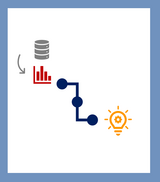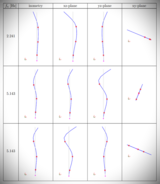Publications
2023
Jaouadi, Zouhour: "Pareto and Reliability-Oriented Aeroelastic Shape Optimization of Bridge Decks", Dissertation, Weimar, 2023
2022
Mojahedin, Arvin: "Analysis of Functionally Graded Porous Materials Using Deep Energy Method and Analytical Solution", Dissertation, Weimar, 2022
Hanna, John: "Computational Fracture Modeling and Design of Encapsulation-Based Self-Healing Concrete Using XFEM and Cohesive Surface Technique", Dissertation, Weimar, 2022
Zacharias, Christin: "Numerical Simulation Models for Thermoelastic Damping Effects", Dissertation, Weimar, 2022
Jenabidehkordi, Ali: "An efficient adaptive PD formulation for complex microstructure", Dissertation, Weimar, 2022
Zhang, Yongzheng: "A Nonlocal Operator Method for Quasi-static and Dynamic Fracture Modeling", Dissertation, Weimar, 2022
Yousefi, Hassan: "Discontinuous propagation fronts: linear and nonlinear systems", Dissertation, Weimar, 2022
Liu, Bokai: "Stochastic multiscale modeling of polymeric nanocomposites using Data-driven techniques", Dissertation, Weimar, 2022
Shaaban Mohamed, Ahmed Mostafa: "Isogeometric boundary element analysis and structural shape optimization for Helmholtz acoustic problems", Dissertation, Weimar, 2022
Nouri, Hamidreza: "Mechanical Behavior of two dimensional sheets and polymer compounds based on molecular dynamics and continuum mechanics approach", Dissertation, Weimar, 2022
Jorge Alberto López Zermeño: "Isogeometric and CAD-based methods for shape and topology optimization: Sensitivity analysis, Bézier elements and phase-field approaches", Dissertation, Weimar, 2022
Abinet Kilfe Habtemariam: "Generalized Beam Theory for the analysis of thin-walled circular pipe members", Dissertation, Weimar, 2022
Valizadeh, Navid: "Developments in Isogeometric Analysis and Application to High-Order Phase-Field Models of Biomembranes", Dissertation, Weimar, 2022
2021
Alkam, Feras: "Vibration-based Monitoring of Concrete Catenary Poles using Bayesian Inference", Dissertation, Weimar, 2021
Khademi Zahedi, Reza: "Stress Distribution in Buried Defective PE Pipes and Crack Propagation in Nanosheets", Dissertation, Weimar, 2021
Mauludin, Luthfi Muhammad: "Computational Modeling of Fracture in Encapsulation-Based Self-Healing Concrete Using Cohesive Elements", Dissertation, Weimar, 2021
Wang, Jiasheng: "Lebensdauerabschätzung von Bauteilen aus globularem Grauguss auf der Grundlage der lokalen gießprozessabhängigen Werkstoffzustände", Dissertation, Weimar, 2021
Ren, Huilong: "Dual-horizon peridynamics and nonlocal operator method", Dissertation, Weimar, 2021
Harirchian, Ehsan: "Improved Rapid Assessment of Earthquake Hazard Safety of Existing Building Using a Hierarchical Type-2 Fuzzy Logic Model", Dissertation, Weimar, 2021
2020
Goswami, Somdatta: "Phase field modeling of fracture with isogeometric analysis and machine learning methods", Dissertation, Weimar, 2020
Chowdhury, Sharmistha: "Stochastic Approaches to Selection of Fatigue Crack Growth Model for Life Cycle Assessment", Dissertation, Weimar, 2020
Marcelo José Bianco: "Coupling between Shell and Generalized Beam Theory (GBT) elements", Dissertation, Weimar, 2020
Winkel, Benjamin: "A three-dimensional model of skeletal muscle for physiological, pathological and experimental mechanical simulations", Dissertation, Weimar, 2020
Oucif, Chahmi: "Analytical Modeling of Self-Healing and Super Healing in Cementitious Materials", Dissertation, Weimar, 2020
Chan, Chiu Ling: "Smooth representation of thin shells and volume structures for isogeometric analysis", Dissertation, Weimar, 2020
Salavati, Mohammad: "Multi-Scale Modeling of Mechanical and Electrochemical Properties of 1D and 2D Nanomaterials, Application in Battery Energy Storage Systems", Dissertation, Weimar, 2020
Radmard Rahmani, Hamid: "Artificial Intelligence Approach for Seismic Control of Structures", Dissertation, Weimar, 2020
Rabizadeh, Ehsan: "Goal-oriented A Posteriori Error Estimation and Adaptive Mesh Refinement in 2D/3D Thermoelasticity Problems", Dissertation, Weimar, 2020
Bakar, Ilyani Akmar Binti Abu: "Computational Analysis of Woven Fabric Composites: Single- und Multi-objective Optimizations and Sensitivity Analysis in Meso-scale Structures", Dissertation, Weimar, 2020
Shirazi, Ali Hossein Nezhad: "Multi-Scale Modeling of Lithium ion Batteries: a thermal Management approach and molecular dynamic studies", Dissertation, Weimar, 2020
Theory and aspects of application in civil engineering
PD. Dr.-Ing. habil. Volkmar Zabel
Habilitation, Weimar 2019

Dr.-Ing. habil. Thomas Most
Habilitation, Weimar 2012
*Habilitation is a phase in German academia. It is a post-doctoral lecture qualification, which allows a scholar to become a full professor.
2023
Jorge Lizarazu, Ehsan Harirchian, Umar Arif Shaik, Mohammed Shareef, Annie Antoni-Zdziobek, Tom Lahmer (2023)
Application of machine learning-based algorithms to predict the stress-strain curves of additively manufactured mild steel out of its microstructural characteristics
Results in Engineering, Vol. 20, Dec. 2023, 101587 (DOI)
Yisihak Gebre, Tom Lahmer, Matthias Müller, Abrham Gebre, Esayas Gebreyouhannes (2023)
Effects of Coating Aggregates on Dynamic Properties of Concrete by Impact Resonance Method
International Journal of Engineering & Applied Sciences (IJEAS), Vol.15, Issue 3 (2023) 110-124 (DOI)
Yisihak Gebre, Tom Lahmer, Matthias Müller, Abrham G. Tarekegn, Esayas Gebreyouhannes (2023)
Damping Properties of Concrete with Sand Coated Rubber Aggregates
Journal of EEA, Vol. 41, July 2023 (DOI)
Yisihak Gebre, Tom Lahmer, Matthias Müller, Torben Wiegand, Andrea Osburg, Abrham G. Tarekegn (2023)
Properties of Concrete with Coated Aggregates under Different Loading Conditions
Journal of Research in Engineering and Applied Sciences (JREAS), Vol. 08, Issue 01, Jan 2023 (DOI)
Meisam Ansari, Fabiola Tartaglione, Carsten Könke (2023)
Experimental Validation of Dynamic Response of Small-Scale Metaconcrete Beams at Resonance Vibration, Materials 2023, 16(14), 5029 (DOI)
Mena Abdelnour, Volkmar Zabel (2023)
Modal identification of structures with a dynamic behaviour characterised by global and local modes at close frequencies, Acta Mechanica 2023 (DOI)
Yohannes L. Alemu, Bedilu Habte, Tom Lahmer, Girum Urgessa (2023)
Topologically preoptimized ground structure (TPOGS) for the optimization of 3D RC buildings, Asian Journal of Civil Engineering 2023 (DOI)
Meisam Ansari, Christin Zacharias, Carsten Könke (2023)
Metaconcrete: An Experimental Study on the Impact of the Core-Coating Inclusions on Mechanical Vibration, Materials 2023, 16(5), 1836 (DOI)
Omar Alrayes, Carsten Könke, Ean Tat Ooi, Khader M. Hamdia (2023)
Modeling Cyclic Crack Propagation in Concrete Using the Scaled Boundary Finite Element Method Coupled with the Cumulative Damage-Plasticity Constitutive Law, Materials 2023, 16(2), 863 (DOI)
2022
Christin Zacharias, Carsten Könke, Christian Guist (2022)
A New Efficient Approach to Simulate Material Damping in Metals by Modeling Thermoelastic Coupling, Materials 2022, 15(5), 1706 (DOI)
Peralta , J., Walther, C., Osman, A., Smarsly, K. (2022)
A systematic survey of Internet of Things frameworks for smart city applications, Sustainable Cities and Society, Vol. 83 (ISSN 2210-6707)
Harirchian, E., Lahmer, T., Kumari, V., Rasulzade, S. (2022)
Building's Vulnerability Assessment against Natural Hazards by Using Modern Computational Technique. Construction Management, and Computers & Digitization (ISSN 2075-5309)
Muyiwa Alalade, Ina Reichert, Daniel Köhn, Frank Wuttke, Tom Lahmer (2022)
A Cyclic Multi-Stage Implementation of the Full-Waveform Inversion for the Identification of Anomalies in Dams (DOI)
Zainab Riyadh Shaker Al-Yasiri, Hayder Majid Mutashar, Klaus Gürlebeck, Tom Lahmer (2022)
Damage Sensitive Signals for the Assessment of the Conditions of Wind Turbine Rotor Blades Using Electromagnetic Waves (DOI)
Ayan Chakraborty, Cosmin Anitescu, Xiaoying Zhuang, Timon Rabczuk (2022)
Domain adaptation based transfer learning approach for solving PDEs on complex geometries (DOI)
John Hanna (2022)
Computational Modelling for the Effects of Capsular Clustering on Fracture of Encapsulation-Based Self-Healing Concrete Using XFEM and Cohesive Surface Technique (DOI)
Kumari, V., Harirchian, E., Lahmer, T., Rasulzade, S. (2022)
Evaluation of Machine Learning and Web-Based Process for Damage Score Estimation of Existing Buildings (DOI)
Yongzheng Zhang, Huilong Ren (2022)
Implicit implementation of the nonlocal operator method: an open source code (DOI)
Yongzheng Zhang (2022)
Nonlocal dynamic Kirchhof plate formulation based on nonlocal operator method (DOI)
2021
Albrecht Schmidt, Tom Lahmer (2021)
Efficient domain decomposition based reliability analysis for polymorphic uncertain material parameters (DOI)
Feras Alkam, Tom Lahmer (2021)
A robust method of the status monitoring of catenary poles installed along high-speed electrified train tracks (DOI)
Feras Alkam, Tom Lahmer (2021)
Eigenfrequency-Based Bayesian Approach for Damage Identification in Catenary Poles (DOI)
Huilong Ren, Xiaoying Zhuang, Erkan Oterkus, Hehua Zhu, Timon Rabczuk (2021)
Nonlocal strong forms of thin plate, gradient elasticity, magneto‑electro‑elasticity and phase‑field fracture by nonlocal operator method (DOI)
Luckey, D., Fritz, H., Legatiuk, D., Peralta, J., Walther, C., Smarsly, K. (2021). Explainable artificial intelligence to advance structural health monitoring. In: A. Cury, et al. Structural health monitoring based on data science techniques. Heidelberg: Springer Verlag GmbH, (ISBN 978-3-030-81716-9)
Harirchian, E., Hosseini, S. E. A., Jadhav, K., Kumari, V., Rasulzade, S., Işık, E., ... & Lahmer, T. (2021)
A review on application of soft computing techniques for the rapid visual safety evaluation and damage classification of existing buildings. Journal of Building Engineering, 43, 102536.
Harirchian, E., Jadhav, K., Kumari, V., & Lahmer, T. (2021)
ML-EHSAPP: A prototype for machine learning-based earthquake hazard safety assessment of structures by using a smartphone app. European Journal of Environmental and Civil Engineering, 1-21.
Harirchian, E., Kumari, V., Jadhav, K., Rasulzade, S., Lahmer, T., & Raj Das, R. (2021)
A Synthesized Study Based on Machine Learning Approaches for Rapid Classifying Earthquake Damage Grades to RC Buildings. Applied Sciences, 11(16), 7540.
2020
Harirchian, E., Lahmer, T., Kumari, V. & Jadhav, K. (2020)
Application of Support Vector Machine for the Rapid Seismic Hazard Safety Evaluation of Existing Buildings. Energies, 13(x), xxx.
Harirchian, E., & Lahmer, T. (2020)
Improved Rapid Visual Earthquake Hazard Safety Evaluation of Existing Buildings Using a Type-2 Fuzzy Logic Model. Applied Sciences, 10(7), 2375.
Harirchian, E., Lahmer, T., & Rasulzade, S. (2020)
Earthquake Hazard Safety Assessment of Existing Buildings Using Optimized Multi-Layer Perceptron Neural Network. Energies, 13(8), 2060.
Harirchian, E., Lahmer, T., Buddhiraju, S., Mohammad, K., & Mosavi, A. (2020)
Earthquake Safety Assessment of Buildings through Rapid Visual Screening. Buildings, 10(3), 51.
Bianco, M.J., Habtemariam, A., Könke, C., Tartaglione, F., Zabel, V.
Analysis of support coupling GBT (Generalized Beam Theory) applied in pipeline systems, Thin-Walled Structures 146 (2020) 106439, https://doi.org/10.1016/j.tws.2019.106439
2019
Nickerson, S., Shu, Y., Zhong, D. Könke, C., Tandia, A.: Permeability of porous ceramics by X-ray CT image analysis, Acta Materialia 172 (2019) 121-130, https://doi.org/10.1016/j.actamat.2019.04.053
Rahmani, H.R., Könke, C.: Seismic Control of Tall Buildings Using Distributed Multiple Tuned Mass Dampers, Advances in Civil Engineering Vol 2019, Article id 6480384, 19 pages, https://doi.org/10.1155/2019/6480384
Schietzhold, F.N., Schmidt, A., Dannert, M.M., Fau, A., Fleury, R.M.N. Graf, W., Kaliske, M., Könke, T., Lahmer, T., Nackenhorst, U.: Development of fuzzy probability based random fields for the numerical structural design, GAMM-Mitteilungen 2019;42, https://doi.org/10.1002/gamm.201900004
Schmidt, A., Henning, C., Herbrandt, S., Könke, C., Ickstadt, K., Ricken, T., Lahmer, T.: Numerical studeis of earth structure assessment via the theory of porous media using fuzzy probability based random field material descriptions, GAMM-Mitteilungen 2019;42, https://doi.org/10.1002/gamm.201900007
I. Reichert, P. Olney, T. Lahmer (2019): Influence of the error description on model-based design of experiments, Engineering Structures, Volume 193, Pages 100-109
N. Vu, R. Sauer, T. Rabczuk, H. Park, T. Lahmer, D. X. Thang (2019): A NURBS-based inverse analysis of thermal expansion induced morphing of thin shells, accepted for publication in Computer Methods in Applied Mechanics and Engineering
L. Nguyen-Tuan, S. S. Nanthakumar, T. Lahmer (2019): Identification of multiple flaws in dams using inverse analysis based on hydro-mechanical XFEM and level sets, accepted for publication in Computers and Geotechnics
Z. Jaouadi, T. Abbas, G. Morgenthal, T. Lahmer (2019): Single and Multi-Objective Shape Optimization of Streamlined Bridge Decks, Structural and Multidisciplinary Optimization, accepted
F. Alkam, T. Lahmer (2019): Quantifying the Uncertainty of Identified Parameters of Prestressed Concrete Poles Using the Experimental Measurements and Different Optimization Methods,
Engineering and Applied Sciences, Volume 4, Issue 4, Pages: 84-9.
M. Steiner, J.-M. Bourinet, T. Lahmer (2019). An adaptive sampling method for global sensitivity analysis based on least-squares support vector regression, Reliability Engineering and System Safety, Volume 183, Pages 323 - 340.
H. V. Do, T. Lahmer, X. Zhuang, N. Alajlan, H. Nguyen-Xuan, T. Rabczuk (2019). An isogeometric analysis to identify the full flexoelectric complex material properties based on electrical impedance curve, Computers and Structures, Volume 214, Pages 1 - 14.
F. Tan, T. Lahmer (2019). Shape design of Arch Dams under Load Uncertainty with a Robust Optimization Method, Frontiers of Structural and Civil Engineering, Volume 13 (Issue 4), Pages 852 - 862.





